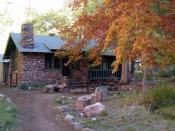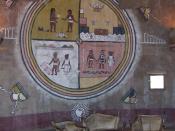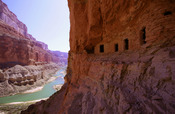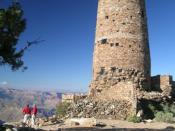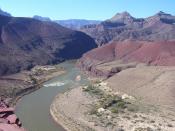Grand Canyon I. About the Grand Canyon, the history of the Canyon and Geologic Story of the Canyon A. Attracts attention of world for many reasons, but greatest significance lies in the geologic record preserved and exposed here.
1. What is unique is the variety of rocks present, clarity with which they are exposed and complex geologic story they tell.
B. Two separate stories exist at Grand Canyon 1. Older story is the one revealed in the thick sequence of rocks exposed.
a. Rock provide remarkable record of the Paleozoic Era b. Show that the rocks of the Canyon are much more older than the rocks itself.
2. Second story concerns origin of Canyon itself: when and how did it come to be? a. Erosional feature that owes it existence to the Colorado River.
b. Equal importance goes to forces of erosion that have shaped and continue to shape Canyon today.
1. i.e., running water from rain, snowmelt and tributary streams.
C. How old is the canyon itself? history and evolution of Colorado River is most complex aspect of Grand Canyon geology 1. Know that erosion shaped which has shaped canyon occurred only in the past five to six million years.
D. Lets talk about some basic facts of the canyon, as you know, the canyon is located in Colorado hovering over the Colorado River.
E. After thousands of years of Native Americans in southwest, first Europeans arrived at Canyon's South Rim in 1540 1. Following 300 years of missionaries, trappers, explorers, govt. surveyors and soldiers roaming the land, A major named John Powell and his crew made the first ever successful boat trip down to Colorado river through the canyon in 1800.
a. This triggered the drawing of visitors and businessmen alike in the late 1800's b. In 1901 the first Passenger train arrived at the canyon c. Canyon became a national monument in 1908, and on Feb. 26 1919 it was designated as the 17th national park.
F. A man named Fred Harvey had the vision of the canyon being the major tourist attraction 1. Though he died in 1901, it was his company "Fred Harvey Company" that was the principal provider of canyon visitor services.
2. This company provided better dining facilities and services then were previously available to travelers.
3. Like I said before, Harvey even convinced Sante Fe railroad to run a line from Arizona to the national wonder, which really helped businesses a lot.
G. To show how special Harvey was, it was his hiring of a gifted architect named Mary Colter, a perfectionist in a male dominated work place, that changed that face of the canyon forever 1. Colter's works included the Hopi House, Lookout Studio, Phantom ranch, Desert View watchtower, and Bright Angel lodge. All were made in the span of 1905 to 1935 and still stand today.
H. In 1968 Amtac purchased FHC, Amtac is recognized as the largest parks management company in the country, located in Denver, Colorado I. Today 5 million people visit the Grand Canyon yearly.
II. Human history A. A professional archaeologist believe that for times reach far to 3000 to 4000 years the desert Archaic people lived within the canyon 1. One way they knew was that people in that time drew pictographs.
B. Desert Archaic seemed to vanish about 1000 B.C. possibly slowly blending their culture with the next group of Indians, the Anasazi 1.Anasazi had already occupied lands east of the canyon for 600 years, before drifting to the canyon by 500 A.D.
C. By 800 A.D. Anasazi started entering a phase known as Pueblo, they probably lived there as early as 1200's 1.Spaniards Francisco Vasquez de Coronado's expedition in 1540 as said earlier brought the first white men to discover the canyon.
a. Mapped region and wrote of it 2. Eventually other trappers and Indians ventured across it in the early 1800's D. By 1800's number of livestock companies were developing canyon by Arizona 1. By 1800's it was there were over 100,000 head of cattle, and 250,000 head of sheep E. James Owens was appointed warden of the Canyon national preserve 1. Built cabin and set up Mountain Lion hunting business 2. Some 12 years later and 600 lions later, Owens began buffalo Ranching F. First tourist facility was constructed in 1917 on North Rim by W.W. Wylie 1. Provided minimum accommodations and was located near Bright Angel Point.
III. Now I will talk more in depth about the American Indians of the Canyon, past and present, since they were the first to inhabit the land A. We'll start with the Puebloan people who made their home in the four corners region, Utah, Colorado, New Mexico, and Arizona.
1.Their record in this region was rich and spans time period from 200B.C. to A.D. 1300 B. Like I said before, the Anasazi occupied lands east of the Canyon for 600 years, and began drifting in the canyon about 500 A.D.
1. By 800 A.D. the Anasazi entered the phase known as Pueblo (basically picking up where Puebloan people left off) C. Ancestral Puebloan people are believed to be ancestors of Hopi People, who inhabited a region east of the canyon.
1. The Hopi people believe they emerged from canyon and that their spirits rest there.
D. The Havasupai, people inhabited the inner canyon in a region west of the Canyon Village 1. In their remote and beautiful corner of the canyon sits the village of Supai and descendants of people who lived there for hundreds of years.
2. Village remains accessible only by foot, pack animal, or from the river but is still heavily visited each year by tourist.
E. Navajo people make up the largest tribes in North America 1. Live throughout the region and on the Navajo reservation, which borders the park to the east.
2. Relative newcomers to this region are descendants of Athabascan, people who migrated into the southwest from the north in the 15th century.
F. Huolapai Reservation borders the canyon to south 1. Are descendants of the Cerbax people and have been there since A.D. 1300 G. South Paiute Indians occupy land north of Colorado River, know as Arizona strip, have traditionally used canyon for years.
H. Finally, the Zuni Indians view the canyon as their place of origin, though they live in New Mexico.
IV. Now we will talk about the size of the canyon A. Park includes well over a million acres of land, roughly about 194 square miles.
1. Most people measure the canyon in Colorado River miles, which is 277 miles long.
a. Colorado river is longer than canyon, flows about 1,450 miles 1. Canyon is only one of many canyons carved by the river.
2. But most will agree, and from seeing the canyon myself, it is miles ahead of any other canyon B. Width and depth of the canyon vary from place to place 1. At the south rim, vertically deepest its about 6000 feet 2. Width of the canyon is about 10 miles long, though in certain spots it is 18 miles wide.
C. Just to give an idea of how big it is, a trip to the bottom of the canyon and back is about 2 days.
1. Hikers may take 3 days one way to get from north rim to south rim 2. A trip through the canyon by raft can take 2 weeks or longer V. Now lets talk a little about the animals that live in the canyon A. The canyon has 75 species of mammals, 50 species of reptiles and amphibians, 25 species of fish, and over 300 species of birds exist B. Canyon is home to wide variety of animals.
1. Mule deer are common, desert big horn, bobcats, coyotes, and small population of mountain lions exist, and these are the bigger animals.
2. Smaller animals are beavers, gophers, chipmunks, rabbits and bats.
3. Lizards, snakes, (including famous pink rattle snake" imagine that, turtles and frogs.
4. Countless birds and insects.
C. Canyon also has number of endangered species.
1. Colorado river fish, birds like falcons or bald eagle.
2. Protected lands like the Canyon provide a refuge for plants and animals that are under pressure elsewhere.
VI. Finally lets talk about the plant life in the canyon.
A. The south rim of the canyon lies on the edge of high plateau whom gray-green forest stand out in sharp contrast to arid lands below.
1. The forest of the canyon are characterized by abundant sunshine, extremes of temperature, long periods of drought punctuated by torrential downpours in summer and snow in the winter.
2. Soil is thin, bedrock lies just a few inches below surface and competition for moisture is keen.
B. On the rim at the highest elevation (7,000 feet), ponderose pine is the dominant tree. Below 7000 feet pinyon pine and Utah Juniper are the dominant trees.
1.Gambel oak is another type common member of the forest C. Below rim is another world, temp. Can be as low as 30F and as high 120F 1. Much of inner canyon is considered desert a. Much of vegetation in inner canyon is typical of that found in deserts to the south.
2. Many areas of cacti and drought resistant shrubs are present D. The Grand Canyon continues to grow and change. As long as rain and snow continue to fall in northern Arizona, the forces of erosion will continue to shape the canyon.
Conclusion In conclusion, I hope you found my speech on the Grand Canyon interesting and very informative; I hope it makes your want to go visit there one day.

